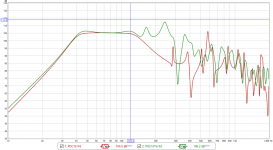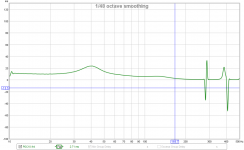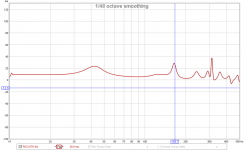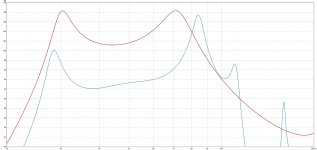I remember reading somewhere that a tapped horn was a "6th order bandpass subwoofer taken to its logical limits". So I took a 6th order BP (series-tuned) sim and adjusted it to look like a tapped pipe (constant CSA from beginning to end, including the chambers), and the response did look like an equivalent tapped pipe sim using the same driver.
I subsequently reduced the csas for the vents and adjusted the chambers in the sim, and I ended up with a 6th order BP sim with basically the same usable passband - in a box that was less than half the volume of the TH. Hmm....
Of course the sim does not include the effect of losses, and it's likely that the difference would be a bit more than pictured in the graph, but we're talking about similar response in half the box size.
So why are 6th order series-tuned BP boxes not more popular?
I subsequently reduced the csas for the vents and adjusted the chambers in the sim, and I ended up with a 6th order BP sim with basically the same usable passband - in a box that was less than half the volume of the TH. Hmm....
Of course the sim does not include the effect of losses, and it's likely that the difference would be a bit more than pictured in the graph, but we're talking about similar response in half the box size.
So why are 6th order series-tuned BP boxes not more popular?
Attachments
So why are 6th order series-tuned BP boxes not more popular?
Helmholtz might look nice in simulation but sounds horrible compared to quarter wave.
I was recently forced against my will to build a 6th order HH based BP, and this is what I designed.
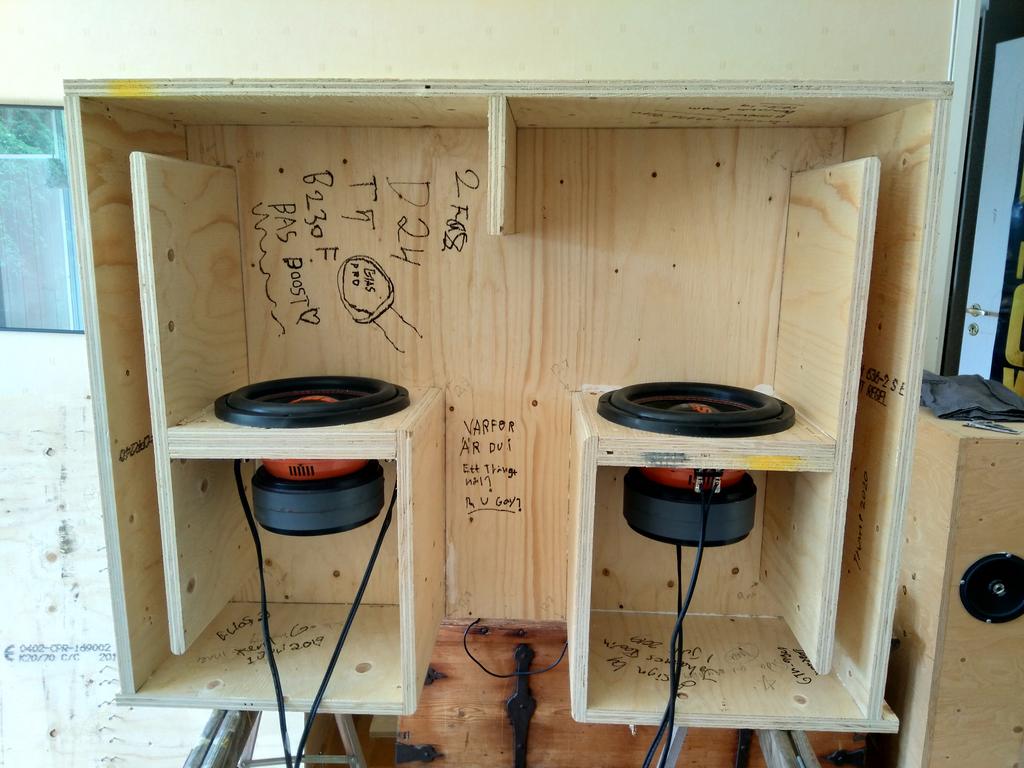

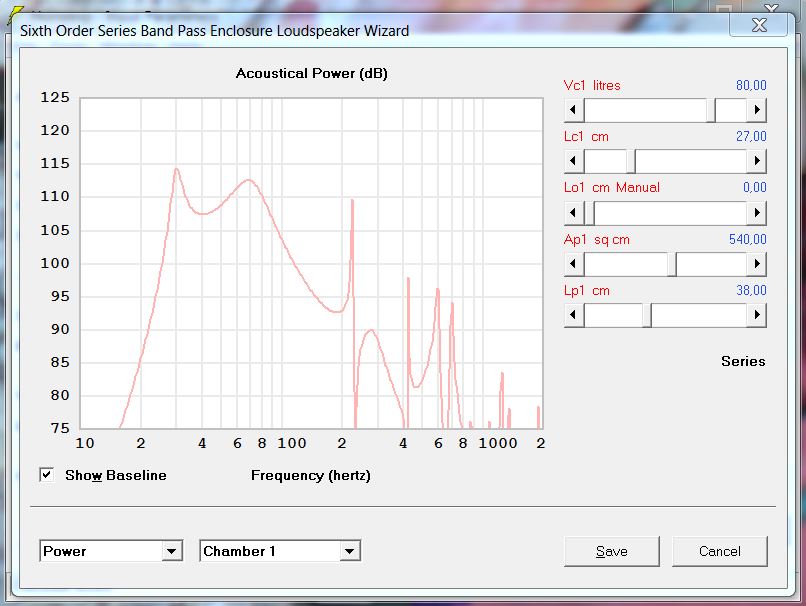
The positive acoustic-mechanic feedback mechanism and the large cross section port makes for a great midbass punch - otherwise seldom heard in 6th order HH BP.
The sound quality does not come close to a QW-based high order BP - even with with the positive feedback and the large cross section port.



The positive acoustic-mechanic feedback mechanism and the large cross section port makes for a great midbass punch - otherwise seldom heard in 6th order HH BP.
The sound quality does not come close to a QW-based high order BP - even with with the positive feedback and the large cross section port.
The sound quality does not come close to a QW-based high order BP - even with with the positive feedback and the large cross section port.
With that precipitously steep drop-off at the low end and ringing around the lowest frequency in the passband, I can quite understand why that particular alignment would sound horrible. GD must be awful...
With the sims I illustrated, GD in the passband is very similar between the BP and TH sims. In fact, the GD looks better for the BP sim at higher bass frequencies.
Attachments
While the frequency response is similar, how does excursion compare?
Chris
I didn't notice any significant difference in excursion between the two sims.
GD looks better for green one, and take into account post #1 it's indexed to TH while red one is BP, did you inverted the graphics or the analysis?
Other then being half-size, for sure the BP construction will be a lot easier then TH, mainly if you just use rectangular vents.
Are you planing to compare them in real life?
Other then being half-size, for sure the BP construction will be a lot easier then TH, mainly if you just use rectangular vents.
Are you planing to compare them in real life?
GD looks better for green one, and take into account post #1 it's indexed to TH while red one is BP, did you inverted the graphics or the analysis?
The green graph is the GD for the 6th order BP sub
I probably won't build these, at least not in a hurry. Real work's taking up too much of my time these days...
as mentioned befiore the little BP6A I had long ago did pretty well - currently I'd like a series BP to do 50-100 punchy and in reasonable bulk

That's actually a pretty good response curve. The out of band stuff seems to be 20 dB down from the passband.
With that precipitously steep drop-off at the low end and ringing around the lowest frequency in the passband, I can quite understand why that particular alignment would sound horrible. GD must be awful
The 150 ms of GD around the lower tuning peak blends nicely with the 250 ms of GD of the car cabin resonance.
In this case it is optimized to give a maximum of impressive and overwhelming bass in a old Volvo with a limited amount of amplifier power available. It is not optimized to give a smooth and nice looking spl response graph.
Not every build is a high end audiophile oriented build where lowest possible GD and smoothest possible measured SPL-response is of outmost importance.
If you are an 18 year old non-audiophile kid fueled by testosterone, beer and red bull, driving a 1978 Volvo 240, then that peak is much more impressive then any smooth spl-response graph in the universe.
The red curve is the 6th order HH based BP, and the blue curve is the 8th order QW-based BP.
This 8th order HROAR sounds much better both indoors in our house and in the car then the 6th order bandpass. I can´t see this in the simulation or in the GD graph. The 8th order HROAR even looks worse, and based only on simulation it should sound worse.
The spl-graph is not everything when it comes to sound reproduction.
There are many other factors that is more important then simulated or measured response curve.
This 8th order HROAR sounds much better both indoors in our house and in the car then the 6th order bandpass. I can´t see this in the simulation or in the GD graph. The 8th order HROAR even looks worse, and based only on simulation it should sound worse.
The spl-graph is not everything when it comes to sound reproduction.
There are many other factors that is more important then simulated or measured response curve.
Attachments
Not every build is a high end audiophile oriented build where lowest possible GD and smoothest possible measured SPL-response is of outmost importance.
So, in summary, you designed and built a 6th order BP system that the sims suggested would sound horrible, and you use that as an example of why 6th order BP systems sound horrible?
Interesting logic...
This 8th order HROAR sounds much better both indoors in our house and in the car then the 6th order bandpass. I can´t see this in the simulation or in the GD graph. The 8th order HROAR even looks worse, and based only on simulation it should sound worse.
The spl-graph is not everything when it comes to sound reproduction.
There are many other factors that is more important then simulated or measured response curve.
Both of them look equally bad to me (reminds me of the response curve of my first bandpass build, which I thought sounded decent, but made every music track sound like the same musical instrument was used to produce the bass spectrum in the track, LOL). But you have a point in your last sentence - the most important factor IMO is listener preference. Doesn't matter how smooth the measured results look like, if the listener wants a peaky bass response.
Both of them look equally bad to me
That is the point i was trying to make.
Despite looking equally bad, the QW sounds much much better then the HH.
The red curve is the 6th order HH based BP, and the blue curve is the 8th order QW-based BP.
These are exported SPL curves from HR simulation NOT measurements of the real systems correct?
- Status
- This old topic is closed. If you want to reopen this topic, contact a moderator using the "Report Post" button.
- Home
- Loudspeakers
- Subwoofers
- Tapped Horn vs. 6th Order Bandpass (series)
